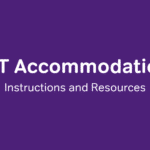
Develop an “eye for grammar.” Wear your monocle and get to it.
I know someone* who picks out grammatical mistakes wherever they show up: flyers, menus, signs, newspaper articles, instruction manuals, etc. She’s often tempted to circle them. On occasion, she has given into this temptation.

Noooo! Do you see it?!
Whether or not you share this error-hunting attitude, you should adopt it for the Writing section. In school, someone reads a draft of your essay and (among other things) will circle/underline any grammar mistakes for you to correct later. On Error Identification questions, you are now the grader and must pinpoint the mistakes that need fixing.
In the 1st section of Writing multiple choice, questions 12—29 are Error ID (Chris often calls these “Identifying Sentence Errors” questions – different name for the same thing). For most test-takers, these are the quickest and easiest ones. The bulk of your time will (and should) go into the other multiple-choice questions (Sentence/Paragraph Improvement). This chunk of Error IDs (18 questions total) is an opportunity to speed up your progress and boost your score with less effort. Yay!

I can’t decide if this is cute or terrifying.
What’s Required
Spot-the-Error. That’s it. Read the sentence with a sharp focus and find the weakness, OR decide that the sentence is already perfect as is (about one-fifth of questions have no error). Repeat 18 times.
Advantages of Error ID Questions
- Easier than Sentence Improvement—Instead of reading 5 sentences, you’re only reading ONE.
- You don’t have to correct the errors. You only have to FIND them.
- Punctuation is rarely tested here. If anything, it usually involves commas.
- Spelling and capitalization are not tested at all.
Potential Disadvantages (or: Reasons to study)
- Some of the errors are very subtle, and therefore commonly missed.
- “(E) No Error”— This often messes with students’ minds. Your confidence is always being tested, but even more so here. So don’t panic—practice to develop a sense of when “No Error” is appropriate.

Do not push.
- With the exception of (E) No Error, the right answer will be grammatically wrong. This is a deviation from the other question types, and can be tricky at first.
One Suggestion: Do them FIRST
Some test-takers go straight to questions 12—29 and finish as many as they can. THEN they do questions 1—11 (Sentence Improvement) and 30—35 (Paragraph Improvement). I’ve seen a number of students do this. For them, Error ID was sort of a “grammar warm-up” before tackling the tougher questions. This strategy gave them the satisfaction of knowing they quickly knocked out 18 questions first. It also helped them manage their time more effectively.
You can try this method and see if it helps. It’s not a one-size-fits-all, but does work for some. Remember: different strategies work for different test-takers. To study effectively, you have to know what kind of test-taker you are.
How to Answer
- Read the entire sentence (you’d be surprised—some test-takers don’t).
- Look at each answer choice separately and CAREFULLY. Imagine that you have a grammatical magnifying glass.

It sounds silly, but it does help.
- Re-read the sentence. It forces you to look more closely at the sentence and maybe catch something you missed. Even if the sentence looks fine, re-read it; do not immediately jump to E) No Error.
- Use standard Process-of-Elimination to boost your odds by 30%. With 5 answer choices, you start all questions with a 20% chance of answering correctly. Ideally, you can eliminate 3 answer choices and be left with 2, thereby giving you a 50% chance. At this point, it’s a coin toss, and not a bad place to be on a timed test.
- If you’ve gone over the sentence twice and really can’t find an error, don’t doubt yourself. Choose E and move on.
- Don’t dwell on these. If you spend too much time on Error ID questions, you lose time on the others (which take longer)!
- Prove it to yourself: When answering, quickly ask yourself: “If this is the error, what should replace it?” If you can give a clear answer, you can move on with confidence.

Substitute with…?
That last one is especially important, especially for studying. Determining “What it SHOULD be” will further develop your sense of right vs. wrong grammar. When practicing Error ID, write in the correction or make a mental note of it. Although this isn’t required on the actual test, it’s very helpful during prep.
Want to practice?
Of course you do. Try this set of 18 Error ID questions.
*This person may or may not be me.
Images from: Pixabay, Wikimedia, Flickr, Daily Genius, and Daily Edge.






Leave a Reply